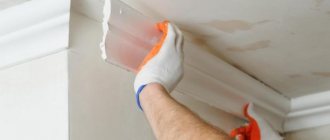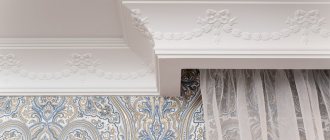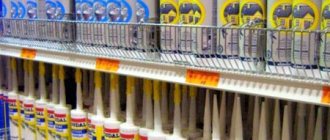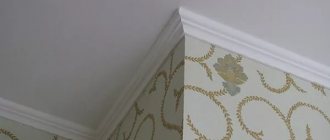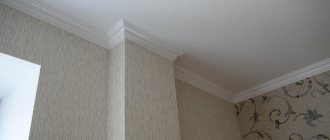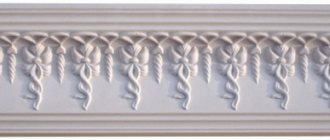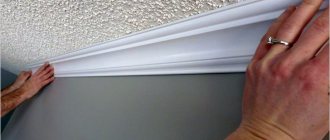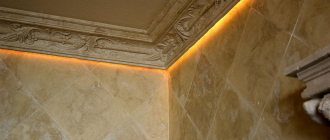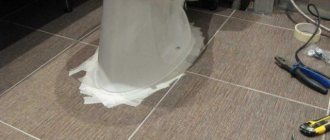Visitors to our site have probably noticed that when complex work is done, there are fewer errors and defects. The reason is increased care and responsibility. But when it comes to seemingly simple work, problems arise. This statement fully applies to the final stage of repair work - gluing the ceiling plinth, especially from foam plastic. Either the corner is not cut properly, then part of the fillet is sagging, then the glue begins to dissolve the baguette material, etc. Theoretical preparation does not help either - a lot of nuances arise in the process of work.
So that a home craftsman can quickly and efficiently do the work with his own hands, let’s look at how to properly glue a foam plastic ceiling plinth.
Advantages and disadvantages of polystyrene foam
The industry offers ceiling moldings from a variety of materials: gypsum, polyurethane, plastic, MDF, wood, polystyrene, etc. However, foam fillets are the most popular among consumers. There are several reasons:
For information: foam plastic refers to a whole class of white plastics with a foamed structure. In the production of fillets, extruded polystyrene and polymerized styrofoam granules, also called expanded polystyrene, are used. The resulting materials differ significantly from each other in terms of consumer and technical-technological indicators, and therefore must be considered separately. Many construction specialists do not see the difference and confuse the advantages and disadvantages of materials, as well as methods of attaching them to the wall. In this work we will talk about styrofoam baguettes, i.e. about the material that gave the name to polystyrene foam.
- affordable price for all segments of the population;
- durability - service life is determined by several tens of years;
- simple installation, accessible to any beginner: just be careful and patient;
- light weight, which allows you to easily glue the fillet onto wallpaper, including liquid wallpaper;
- sufficient choice in surface shape and size, which allows you to use foam plinth in any interior design style;
- beautiful appearance - they look strict and elegant, adding a certain chic to the decoration;
- lack of response to changes in temperature and humidity - no linear expansion;
- possibility of painting with acrylic water-based emulsion in a different color and installation under a suspended ceiling;
- the material does not have any special maintenance requirements;
- you can stick it to any wall surface: wallpaper, paint, whitewash, concrete, brick, drywall, etc.;
- environmentally friendly - there are no harmful emissions into the air, therefore, there are no allergic reactions to the material;
- polystyrene foam is not a breeding ground for mold and fungi - they do not reproduce even at high humidity and temperature. Therefore, it can be installed in the bathroom and kitchen.
There are also disadvantages, but practically no attention is paid to them. Among the disadvantages:
- The granularity of the material does not make it possible to beautifully design the joint: it is not possible to cut perfectly smoothly - some grains are not cut, but fall out. Additional treatment of the seam with sealant or putty is required;
- the ability to melt in glue solvents, therefore, before starting work, it is necessary to apply a little glue to the tip of the panel and see the reaction of the material;
- fragility - easy to damage with slight deformation, therefore it is necessary to work very carefully;
- turn yellow over time, which can be eliminated by painting;
- dismantling is only destructive (the plinth strips can only be saved when removed together with the wallpaper).
Options for attaching foam baseboards
Experts, when considering options for attaching a foam baguette, highlight the method and location of attachment.
According to the method of fastening, the following are distinguished:
- all types of adhesives using water as a solvent;
- acrylic putty;
- acrylic or silicone sealant;
- liquid Nails.
In addition, sometimes a mechanical method of fastening is used - staples that are driven in with a tacker or, as people say, a “construction stapler.”
The mounting location can be:
- wallpaper, including liquid wallpaper;
Attention: for heavier baguettes, liquid wallpaper is removed so that it can be attached directly to the wall (it does not support the weight). You don’t have to perform such an operation with foam plastic - it’s lightweight.
- paint, whitewash or putty. With this option, there is an excellent opportunity to level out the curvature of the walls with paste putty (close the gap between the wall surface and the fillet);
- ceiling or wall and ceiling - used when there is poor adhesion of the adhesive to the wall surface. For example, applied liquid trellises, which with a suspended ceiling must be removed under the plane of the baguette.
In practice, installing a ceiling plinth on a wall without finishing is very rare - the difficulty of wallpapering or painting the walls increases.
DIY glue
If you have doubts about the quality of the products offered, try preparing the adhesive composition yourself. It's quite simple and not expensive. You will need:
- PVA glue;
- gypsum putty;
- water.
Stages of creating glue:
- Dilute the putty with water and stir until a thick and homogeneous mass is obtained.
- Add office glue to the resulting mixture in a ratio of 1:4.
- Stir the mixture and leave for 5 minutes. The glue is ready.
The disadvantage of this material is its long hardening time. Gluing the baseboard will take much more time compared to industrial adhesive products. But it is not forbidden to work with putty indoors, since it does not have a strong odor. Another plus is that during the gluing process, the composition can smooth out the unevenness of the wall. The mixture is applied with a spatula, after which the plinth is installed on it.
Materials and tools
Before starting work, you need to purchase materials:
- foam baseboard;
- glue (liquid nails or acrylic putty);
- sandpaper P100 (P120).
In addition, you will need:
- ladder;
- a construction knife with a replaceable blade - only it gives an acceptable quality cut;
- miter box;
- roulette;
- construction pencil;
- narrow spatula;
- ruler;
- a rag or sponge to remove excess glue protruding from under the baguette.
Polyvinyl acetate based adhesive
This glue is not characterized by strong odors and can be easily used. True, it will be used up quickly, because it needs to be applied both to the foam baseboard and to the ceiling.
Therefore, it needs to be taken in a large container, and this is very expensive. For this reason, you will also spend a lot more time working.
Which glue to choose
When preparing for work, a logical question arises - what kind of glue to use on ceiling plinths made of polystyrene foam. After all, polystyrene foam, firstly, is corroded by solvents, secondly, it does not have adhesion with some types of adhesive - it simply rolls off the surface of the baguette, and thirdly, it is very light.
The following conditions are fully met:
- polyurethane foam;
- polymer glue;
- acrylic putty;
- acrylic or silicone based sealant;
- "liquid Nails".
The following list shows how you can attach a plinth to a wall or ceiling. But this does not mean that every type of adhesive is technologically advanced and financially effective. For example, the use of sealants due to their high cost is pointless, and acrylic putty and polyurethane foam can only be used to glue ceiling plinths to a bare, unfinished wall.
Glue
Glue is best used in situations where it is necessary to connect the fillet to the wallpaper. But it should be remembered that for foam plastic the choice of adhesive composition is limited due to the chemical reaction of the styrofoam from which the baguette is made with paint solvents. Therefore, it is very easy to give advice here: “Titan”, “Eko-Hacet” or “Moment of installation”. Detailed characteristics of each type of glue can be found in the work “How to choose glue for baseboards.” We will pay attention to several nuances:
- using “Titan” (0.5 l costs 150 rubles and more) and “Moment installation” (price of 0.25 l starts from 200 rubles) is very financially expensive. Here, in relation to polystyrene foam, the quality indicators of the glue are many times overestimated, which affects the price;
- “Eko-Hacet” is affordable (from 65 rubles for 0.25 l), but it is a contact type, which is not taken into account by most consumers. The glue has a completely different application technology: a layer of “snake” is applied to the fillet, after which the plinth is pressed tightly against the wall and ceiling for a few seconds to leave a mirror trace of the adhesive. After which the baguette is set aside for the time indicated on the packaging (usually 5-10 minutes) to allow adhesion properties to develop.
Attention: in some cases, Moment glue can also be contact glue. This feature needs to be clarified with the seller or carefully read the instructions on the package.
Editorial advice: it is better to refuse glue for attaching foam baguettes for financial and technological reasons.
Polyurethane foam
The most budget option for attaching a baguette is polyurethane foam. But to use it, two conditions are required:
- wall without finishing;
- a baseboard with free space on the back side (a groove or be concave) into which the foam can expand without tearing the fillet away from the wall.
Acrylic putty
If the wall is not covered with wallpaper, there is no need to choose glue for a long time - it is acrylic putty. The option is the most optimal for the following reasons:
- affordable;
- easy to apply;
- instant grip, sufficient for long-term fixation of the baguette without using your hands;
- using putty, wall unevenness is repaired;
- completely harmless to humans.
When applying paint, it is necessary to prime the wall at the place where the fillet is attached with penetrating solutions in two layers.
"Liquid Nails"
Liquid nails may contain different chemical components. For polystyrene foam, you need to buy glue made from synthetic resins on a water-acrylic basis. It sets quickly (from 15 seconds to 30 minutes, and Tytan professional writes generally 5 seconds), has excessive tear strength for foam plastic (40-60 kg/m2), can be used in a wide temperature range: from – 40 to +35oС.
The rather high cost, although with a careful search you can find affordable prices, is compensated by low consumption (can be applied spotwise) and convenient packaging.
Conclusion: “liquid nails” are a good alternative to all methods of attaching ceiling plinths. Fillets fixed with their help receive reliable, long-term adhesion to the base (wall or ceiling).
Gluing with putty
Installation of the molding before or after general repairs will depend on the glue that is chosen for this work.
While the wallpaper has not yet been pasted, it is better to use putty for baguettes. Experts usually choose this option, since baseboards are best attached to a “bare” base.
Putty is a substance that can be bought at any hardware store, or plaster may be left over after other repair work. Typically, this product can be purchased in the form of a ready-made or dry mixture.
If the mixture is dry, then it should be without lumps. If you have experience in such work, then you can buy a composition based on gypsum, but you need to know that it dries quickly.
Therefore, this mixture is diluted in small quantities. To improve adhesion, they also purchase a primer, and the tools you need to have are:
- A hacksaw (if the cornice is wide), a stationery knife (if the cornice is narrow);
- Miter box (optional);
- Not a wide spatula;
- Fine sandpaper.
The work is divided into several stages. From the beginning comes the preparatory:
- Defects and recesses must be removed along the entire perimeter. If a thin baguette is to be installed, the surface must be perfectly flat. Sanding is done with sandpaper.
- Apply the primer, then wait for it to dry. This procedure must be done first.
- They make markings. Take a pencil and put the baguette in place, then mark the joint with a pencil. You can also immediately draw a diagram of the layout of the baguette, even before purchasing the material.
- Cut out the details. This moment will be the most difficult for beginners, especially if the molding on the ceiling is made of foam, because it is fragile and can crumble. Corners are cut at 45 degrees, and sticks are cut in a straight line. You need to try to do this in small pieces from the beginning.
Next, the process of gluing onto the putty mixture begins. You need to dilute it according to the instructions - dilute it with water in a container, mix it either with a mixer or without tools. It is better to start diluting with a small amount, gradually increasing the volume. And then you should proceed like this:
- Pick up some funds;
- Spread the foam on the inside with a thin strip;
- Excess must be removed with a cloth;
- Glue from the corner;
- Press the stick into the desired place according to the markings, check the correct position;
- There is no need to press the baguette hard on the ceiling;
- Wipe off the excess again or use it to fill the voids, if any;
- Before gluing the second stick, the end is greased with putty mixture;
- This is how the work is done around the entire perimeter, then left to dry for a day;
- After drying, clean the skirting boards on the ceiling; if necessary, paint them.
Criteria for choosing a plinth
When buying a plinth, you need to successfully fit it into the dimensions and interior of your apartment or house. For example, not only the strength of the connection with the wall, but also the visual perception of the volume of the room depends on the width of the fillet. So, in small rooms, narrow baguettes look better, unlike wide ones: they reduce the volume. Table 1 will help you make your choice, where designers give the optimal ratios of the fillet and the size of the room.
Table 1.
| Ceiling height, m / Room area | 2.5 | 2.7 | 3 |
| Up to 15 m2 | 3-5 cm | Up to 9 cm | Up to 10 cm |
| 15-23 m2 | 5-7 cm | 9-14 cm | 10-15 cm |
| More than 23 m2 | 7-9 cm | 14-18 cm | 15-21 cm |
It is useless to give specific recommendations regarding the design of the plinth, since “there is no friend for taste and color.” However, it is still worth citing expert recommendations.
- If there are a large number of internal and external corners, it is best to purchase a fillet with a relief surface - the junction of the wall with the ceiling and the corners themselves look more harmonious.
- When finishing a ceiling with two or more levels, preference should be given to a baguette with a smooth surface.
- For classical trends in design, it is better to buy decor with a stucco surface; for modern trends (high-tech, eco-decor, etc.) - smooth and narrow.
- A narrow, smooth plinth looks good in any design, from simple to sophisticated.
- The white color of the fillets, together with the light ceiling, visually expands the room.
- For suspended ceilings, it is advisable to paint the baseboard to match the color of the canvas.
- It is better to abandon the complex shape of the surface - difficulties arise with corner connections.
What characteristics should you pay attention to when choosing
When choosing and purchasing foam ceiling plinths, you should pay attention to the following distinctive features and technical characteristics of the products:
- Foam density - as a rule, sellers offer materials with a volumetric weight from 25 to 40 kg/m3. As the density increases, the price increases, but at the same time, the element has increased compressive and bending strength.
- Element profile shape - different manufacturers supply foam ceiling plinth to the market in 4 main types of profile shapes:
- Concave design is the classic type.
Concave part profile shape
- Convex shape - used mainly for modern interiors.
Convex part profile shape
- Figured dressing of complex configuration.
Figured finishing of the part profile
- Design of bas-relief in antique, Indian and other styles. The range of products is very large, and each owner of the premises can choose the decor to suit his taste.
Image of artistic bas-relief on the surface of the part
- Cross-sectional dimensions and length of parts. Products are supplied to the market from 2.5 to 3.5 - 4 meters in length, with profile dimensions from 15 - 25 mm to 200 - 400 mm, depending on the style.
- The plinth can be of symmetrical or arbitrary (asymmetrical) section.
Symmetrical profile section
- Composition and flammability class. The material should not contain formaldehyde or other toxic compounds, and the base should be self-extinguishing, which also guarantees its fire safety.
- Surface type – products are offered in both technical and finishing versions.
An element that does not require finishing
When choosing, it is also worth studying the main suppliers and the presence of positive reviews on forums on the Internet about their products, indicating the pros and cons.
Sticker instructions
The instructions on how to glue foam ceiling plinths have two sections:
- preparatory work;
- baguette installation technology.
Preparatory work
Before starting work on gluing the ceiling plinth, you need to perform several simple operations:
- move all furniture away from the walls, if this was not done at previous stages of finishing;
- clean the area around the baguette from dust and dirt;
- prime the plastered (painted) wall, as well as the ceiling;
- determine the start and end location of the work. This is especially important when the surface of the fillet is embossed. After all, the planks can be joined according to the pattern only in 3 corners. In the latter it is almost impossible to do this. Therefore, it is advisable to hide the last connection, for example, in a darkened area or behind curtains.
Important: experts advise that if the surface of the plank is smooth, first glue the plinth in the corners, and then complete the work on the wall - this makes it easier to adjust the corner joints. When imitating stucco or pattern, work starts from any angle and proceeds in opposite directions.
Care of the ceiling plinth after installation
After installing and finishing the decorative element, it will serve for many years. However, in order for the part not to lose its impeccable appearance and performance qualities, it must be provided with simple periodic maintenance:
- From time to time, dust settles on the surface of the baseboard, which must be brushed off with a soft-bristled broom.
Cleaning the baseboard in the room
- If the finished coating of the ceiling and baseboard is highly resistant to the aggressive effects of water, it is allowed to carry out wet cleaning of the elements.
- If, after some time of operation of the room, certain sections of the plinth have moved away from the wall, forming a gap, they should be glued using transparent silicone, which will not leave visible marks on the wallpaper or ceiling.
With simple maintenance, the interior detail can last no less than the finishing of the main part of the ceiling structure. a correctly selected and correctly installed ceiling plinth ideally emphasizes the impeccable taste of the owner of the room and adds expressiveness to the interior.
Fillet installation technology
Begin gluing the baseboard from the most visible corner. The step-by-step work algorithm is as follows:
- The ends of the baguettes are cut for a beautiful connection in the corner, after which the convergence of the ceiling plinths is checked below in the same corner. If everything is fine, the next step is taken;
- An adhesive is applied to the reverse side. “Moment” and “Titan” - with a snake. “Liquid nails” - dotted, putty paste with a narrow spatula in a continuous mass on the back side of the baguette or on the wall and ceiling;
- immediately after applying the glue, the fillet is pressed against the wall and ceiling. The main thing here is to prevent the decorative element from moving down or up;
- The laid baguette is held by hand or with the help of tailor's pins on the wall in a fixed position until the glue sets. The time is always indicated on the packaging. If it says: instantly, you shouldn’t believe it. In this case, it is better to ask the seller how long it is necessary to hold the parts to be glued, since no glue, except contact glue, is capable of immediately holding the parts to be glued;
Attention: we remind you once again that contact types of glue require time to gain adhesive strength.
- remove any excess glue with a rag, carefully so as not to smear the wallpaper;
- in the same sequence, fillets are attached around the perimeter of the room;
- the gaps between the wall and the molding, as well as the joints, are sealed with sealant.
You can watch a lesson on attaching foam baseboards in the video below.
How to make corners
The most difficult moment in the entire technology of finishing the junction of a wall and a ceiling is to obtain the correct cut of the end of the fillet for the connection in the corners. If the walls are plastered before applying the finishing, there should be no problems, since the angle in this case is set to almost 90o. In this case, cutting a 45o end at the baseboard is not difficult. But for this you need a special device - a miter box. How to work with this tool is described in detail in the work “How to use a miter box for a baseboard.”
Difficulties begin if the angle is obtuse or acute. The miter box won't help here. You need calculations, marks with a pencil or marker, and cutting without tools. How to do all this, as well as cut the baguette for the internal and external corners, can be found in the work “How to make a corner on a ceiling plinth.”
What is liquid nail
This product is very often used for ceiling cladding. With it you can stick tiles, as well as cover seams and joints.
To use liquid nails, you need to have a special glue gun in your arsenal that dispenses the product in the right quantity.
Liquid nails are applied pointwise to the foam baseboard in the center and edges. To level the ceiling you need to apply a little more product.
It is recommended to leave a little space from the edge so that after pressing the foam plinth to the surface, the glue does not leak out.
The nuances of installing foam plinth under a suspended ceiling
Attaching the ceiling molding is the logical conclusion of the repairs being carried out. It hides the junction of the wall and the ceiling, where the border of different finishing materials is located. However, due to two types of ceilings - tension and rigidly fixed (plasterboard or concrete floors), there are nuances in installing fillets.
- The rules for choosing a baguette are changing. So, for a stretch ceiling, the width of the lower part should be sufficient to be held with glue on the wall surface. After all, unlike a hard surface, glue can only be applied to the side plane.
- The upper part of the ceiling plinth should not touch the fabric of the suspended structure. The optimal distance is 2-3 mm.
- With a suspended ceiling, the shapes and sizes of fillets, etc. are visually perceived differently.
You can read more about fixing a baguette under a suspended ceiling in the material “Plinth for a suspended ceiling.”
Possible errors and ways to eliminate them
If the baseboard has fallen off or sagged, errors were made in the work. Let us list the most typical of them.
- Mounting is done on a dusty or dirty surface. Therefore, before starting work, grease stains and soot are removed from paint or putty. The surface is primed, as a result of which the dust binds, and the adhesive properties of the walls increase. The wallpaper is cleaned of dust, and greasy stains are removed along with the wallpaper.
- An error was made when choosing glue. It either contains solvents that corrode the baseboard, or is not intended for gluing foam to wallpaper or paint. The problem is solved by carefully studying the recommendations printed on the packaging.
- No attention was paid to the contact nature of the glue, as a result of which it does not hold due to a violation of the gluing technology.
- There are drafts in the room. Foam ceiling plinth, like wallpaper, categorically does not tolerate drafts: the glue dries quickly, as a result of which, firstly, it is difficult to adjust the position of the molding on the wall, and secondly, if the glue dries unevenly, there is a risk of deformation of the fillet. As a result, the baguette will be fixed to the wall (ceiling), but the quality of work in this case is not the best.
- The time for fixing the fillet with hands or auxiliary materials to set the adhesive mass was incorrectly selected.
Little tricks or expert advice
An analysis of various forums showed that home craftsmen mostly have typical questions:
- Is it possible to paint a baguette;
- how to make a corner;
- how to glue foam skirting boards to the ceiling, etc.
The editors have summarized them and provide recommendations from professionals.
- It is both possible and necessary to change the white color of the fillet to one of the colors in the palette. For these purposes, acrylic water-based paint with added color is suitable. It is advisable to paint before attaching the molding to the wall - the quality of painting is better. You can repaint the baseboard on the wall as well. But then you need to be especially careful so that the colored spots do not end up on the wallpaper. After filling the joints with sealant, they are corrected with a small soft brush, which is usually used when working with watercolor paints.
- The required amount of plinth is determined simply: one fillet is added to the perimeter of the room for unexpected losses.
- The stretch ceiling is protected from glue by cling film.
- Cutting the corners of the plinth for joints in the corners is best done in a device that builders call a wort.
- If the walls in a room are decorated with two types of materials, for example, on one part of the surface there is a trellis, and on the other there is tile, then how to glue the fillet onto the tile in this case? You'll have to buy "Titan" or "Moment Montage". Other adhesives do not hold well.
- It is easier to adjust the corner plinth to size using the following scheme: cut a 45o corner at the right and left baguette; the quality of the joint in the corner is checked; if necessary, the ends are adjusted; the length of the corner fillet is determined (you can measure it with a tape measure or attach the baguette to the wall and mark the cutting line with a knife or pencil); in a miter box at an angle of 90o with a knife, the plinth is cut to size.
How to glue baguettes to different surfaces
The principle of operation depends not only on the type of product, but also on the type of base to which the baguettes will be glued. They need to be taken into account when working independently.
On a suspended ceiling
Narrow foam materials are selected, in which the upper part is the same as the lower one. Then you will be able to apply glue only to the area attached to the wall; you cannot touch the stretch ceiling. The adhesive solution must have a high level of adhesion.
You should work carefully so as not to leave glue stains on the ceiling covering, as they can ruin it.
Narrow foam materials are selected, in which the upper part is the same as the lower one.
For wallpaper
Skirting boards can be glued to wallpaper only if they are securely fixed. The adhesive mixture must have reliable fixation. To avoid glue getting on the canvas, masking tape is glued to the bottom of the marking border.
Skirting boards can be glued to wallpaper only if they are securely fixed.
On drywall
Joint areas are considered a difficult area to work with. Where the putty may be uneven, it is smoothed out using sandpaper. Plasterboard sheets reduce the space of the room, so for visual interest, panels are glued with the wide side to the ceiling covering.
For visual interest, panels are glued with the wide side to the ceiling covering.
For plaster
The plaster may be uneven, so it is advisable to treat it with a putty mixture. If necessary, resort to applying a primer and sanding the surface.
The plaster may be uneven, so it is advisable to treat it with a putty mixture.
